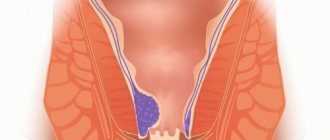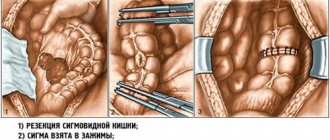Surgeon, coloproctologist
Skorkina
Irina Konstantinovna
15 years of experience
Doctor of the highest category, member of the European Society of Surgeons
Make an appointment
Gastrointestinal pathologies occur in almost every person. Deviations from the norm occur in 95% of the population. Most often, people are bothered by pain in the gastrointestinal tract, digestive disorders, etc. Conditions called tenesmus deserve special attention. This is a painful and unpleasant urge to have a bowel movement. In this case, defecation, as a rule, does not occur. With tenesmus, mucus may come out of the rectum instead of feces, and sometimes there is bloody discharge or pus. A person with this pathology experiences pain. The location of discomfort is the anus, perineum, and sacral area. Pain is also sometimes felt in the gastrointestinal tract. Some patients described this uncomfortable condition as follows. There is a feeling of distension of the intestines from feces. However, after visiting the toilet there are no results - defecation does not occur. Feces, if they come out, are in small quantities.
This condition is characterized as uncomfortable when there is an urge to empty the large intestine, but bowel movements are not observed. This phenomenon is sometimes associated with disruption of the gastrointestinal tract and other dangerous pathologies, including cancer. Inflammatory processes in the intestines, colorectal cancer, and irritable bowel syndrome can provoke false urges to bowel movement. Tenesmus can also be caused by problems in the genitourinary area, etc. To accurately determine the cause of this phenomenon, you need to undergo diagnostic procedures at a medical institution.
Causes and symptoms
Such a condition as tenesmus has different causes. Presumably, the occurrence of pathology is promoted by inflammatory processes in the large intestine. Moreover, inflammation can be of both an infectious and non-infectious nature.
The phenomenon can be short-term or permanent. Short-term manifestations disappear after visiting the toilet. Constant discomfort can occur in the patient even in a calm state. As mentioned earlier, tenesmus is a manifestation of one or another pathology of the gastrointestinal tract or genitourinary area.
The inflammatory process in the gastrointestinal tract sometimes provokes narrowing, blocking, perforation or scarring of the intestinal walls. As a result, the movement of feces becomes difficult, and false urges to defecate occur.
Let us list the main reasons due to which this anomaly of intestinal motility occurs:
- ulcerative colitis;
- intestinal infections;
- Crohn's disease;
- rectal gonorrhea;
- irritable bowel syndrome;
- colorectal cancer;
- hemorrhoids and others.
As you can see, intestinal tenesmus has a variety of causes, so you should promptly be examined by a specialist to find out the causes of the pathology.
Fear of defecation
Fear of defecation occurs with fissure, cryptitis, papillitis. Suppressing the urge to defecate leads to stool retention and rectal overflow. Its overstretching reduces the sensitivity of the receptors, which reduces the urge reflex. Feces are spontaneously released through the anus. In these cases, encopresis is preceded by constipation of psychological origin (psychogenic). One of the causes of false encopresis is intestinal infections suffered in infancy, which lead to degenerative changes in the intramural ganglia of the intestine. The latter are in an immature state at the time of birth and mature after birth.
Due to functional and later organic changes in the nerve cells of the rectal wall, the threshold of excitability of mechanoreceptors decreases. In such children, the sensitivity and reflex relationship of the rectum with its sphincter apparatus decreases. The rectum becomes full and the sphincter opens until the urge to defecate occurs. In this case, the cause of fecal incontinence is not dysfunction, but a decrease in the sensitivity of the rectal wall to increased pressure in it.
What to do if you have symptoms of pathology
It is important not to self-medicate, but to seek qualified help. You should undergo an examination in the clinic as soon as possible; the following manifestations of pathology make themselves felt:
- blood in stool;
- a person may feel chills and fever;
- pain in the gastrointestinal tract;
- nausea, vomiting.
All this indicates the presence of an inflammatory process in the intestines. With these manifestations, you need to get medical help as an emergency.
True encopresis
The basis of fecal incontinence in true encopresis is inhibition of the defecation center in the cerebral cortex. The center's control over the perception of the urge to defecate and the opening of the anal sphincters is disrupted. True encopresis is observed much less frequently than false (paradoxical) encopresis, in only 5% of cases.
One of the reasons for true encopresis is stressful situations, the presence of constantly depressing impressions on the psyche in kindergarten, family, and school. Sometimes the parents of these children are divorced and pay little attention to raising the child. In children with true encopresis, astheno-neurotic syndrome is often detected. They had a history of hypoxia during intrauterine development (umbilical cord entanglement, gestosis, toxicosis, maternal anemia, birth trauma, threatened miscarriage); children were often born through cesarean section.
When you urgently need to call an ambulance
An ambulance should be called if intestinal obstruction is suspected. That is, in addition to tenesmus, a person has symptoms such as the inability to empty the intestines for a long time, severe and cramping pain, or slowly increasing pain in the intestines. The symptoms are also dangerous if the patient has vomiting, frequent tenesmus with blood and there is no discharge of gases or feces even after enemas.
Before the ambulance arrives, you should put the person on the bed, apply cold to the stomach and not give any food. In this condition, the patient should not take painkillers and laxatives. You should also not apply a heating pad to your stomach.
Treatment
If a person experiences tenesmus, treatment is prescribed depending on the causes of the pathology, the severity of the condition, etc. It is very important to correctly determine the cause of the phenomenon. If a patient has colorectal cancer, it is better to detect it as early as possible. For this disease, complex treatment is prescribed, which includes a variety of techniques. It is also necessary to begin treatment for inflammatory diseases of the gastrointestinal tract as soon as possible. Early diagnosis of these pathologies is the key to successful treatment results.
At the appointment, the doctor will draw up a complete picture of the occurrence of the disease. The survey may include the following activities:
- blood tests;
- colonoscopy;
- bacterial culture of stool;
- CT scan of the abdominal region;
- screening for sexually transmitted diseases.
The treatment regimen will depend on what particular pathology caused intestinal tenesmus. If the cause of tenesmus in adults is an inflammatory disease of the gastrointestinal tract, then the treatment regimen will be the same. For infectious diarrhea, completely different methods are already used, etc.
Treatment at home
Illnesses that produce false urges to defecate can often be treated at home. However, it should be noted that any use of medicines, including traditional medicine, must be agreed with the attending physician. For example, in addition to the main treatment, the patient is also prescribed auxiliary phytotherapeutic agents at home.
Let's give examples. To achieve temporary relief of the patient's condition, baths with herbal decoctions are sometimes prescribed. Enemas using sea buckthorn and rosehip (for ulcerative colitis) are often used. With dysentery, painful symptoms are eliminated by bed rest, a special diet, drinking plenty of fluids, and taking medications prescribed by a doctor.
Prevention of tenesmus
Preventive measures for this pathology are as follows:
- high fiber diet;
- drinking enough clean drinking water;
- moderate physical activity;
- reducing stressful situations at home, at work, etc.
Not all patients benefit from a high-fiber diet. This preventive measure is very effective for false tenesmus, but is contraindicated in patients with Crohn's disease and ulcerative colitis. You should not take foods with a high fiber content in the following cases:
- period of exacerbation of chronic gastrointestinal disease;
- serious narrowing of the intestinal lumen.
Those people who are not prohibited from such a diet can alleviate their condition by eating:
- legumes;
- nuts;
- vegetables fruits;
- lentils;
- seeds;
- whole grains, etc.
Equally important is drinking water in an amount of at least 2-3 liters per day. This is important for normal and timely bowel movements. Moderate physical activity and sports help improve digestion, restore intestinal motor function and eliminate false urges to defecate.
It is important to maintain a calm state of mind in any situation, as the intestines (and stomach) are very sensitive to stress. For this, relaxation methods, meditation, yoga, psychotherapy, etc. are used.
Calomania
By 2–3 years of age, defecation in healthy children is conscious, volitional, and controlled. Children are clean and tidy. However, the parents of some children begin to notice that the child, who was previously clean, gets his panties dirty and dirty. The child develops stools . This greatly alarms some parents; others consider dirty panties to be a manifestation of the inability to properly perform hygiene skills after defecation; the child is often punished. This circumstance leads to untimely consultation with a doctor. Encopresis occurs when one of the chains of an already formed conditioned reflex arc breaks down.
Answers to some popular questions
Many people are interested in the question of what urinary tenesmus is. Tenesmus is a false urge to defecate or urinate. Therefore, there are intestinal false spasms, and there is also bladder tenesmus. Accordingly, with such spasms, a tonic contraction of the muscles of the rectum or bladder occurs. Spasmodic contraction of the sphincters may also occur simultaneously. In both cases, false spasms do not allow either the intestines or the bladder to empty, that is, they are ineffective. Such phenomena are uncomfortable and may be accompanied by severe pain.
Another popular question from patients is: how to get rid of tenesmus? The success of treatment depends on correct diagnosis. The speed of the patient’s recovery will depend on how quickly and correctly the doctor determines the cause of the pathology. In cases where false urges cause tumors in the rectum, inflammatory, infectious diseases in the gastrointestinal tract, treatment should be started as early as possible. Then the result of therapy will be positive, and the process of recovery from the disease will take less time. Therefore, at the first symptoms of tenesmus, you should not hesitate, but get examined in a professional clinic.
Constipation in children: a neurologist's view
Constipation is one of the common manifestations of many types of nervous system pathologies. In particular, chronic constipation is a symptom of a number of pathological conditions and syndromic conditions affecting the central nervous system (CNS).
Constipation of almost any etiology and severity is fully or partially amenable to dietary correction methods, that is, it is partially associated with the concept of neurodietology [1]. It is not recommended to ignore organic or functional constipation, since in the absence of their systematic correction, pathological changes in the central nervous system, as well as other organs and systems, may appear [1, 2].
Definition
Constipation is a delay or difficulty in defecation that is present for two or more weeks and is severe enough to cause significant discomfort and impairment to the patient.
Physiological aspects of defecation
Normally, the ability to retain feces is ensured by involuntary and voluntary muscle contractions. The internal anal sphincter has an involuntary resting tone, which decreases when stool enters the rectum. The external anal sphincter is under voluntary control. The urge to defecate is triggered when stool comes into contact with the lining of the lower rectum [1, 2].
The gastrocolic reflex (a wave of peristalsis that occurs in the colon when food enters the stomach or soon after) is also of particular importance for the act of defecation), the mechanism of which is explained by the influence of the neuroendocrine system (a number of neurotransmitters and hormones). At the same time, the gastrointestinal tract (GIT) seems to strive to make room for new food. In infants and young children, the physiological gastrocolic reflex after the first meal in the morning is much more pronounced than in older children [1, 2].
Defecation is partially voluntary; contraction of the muscles of the abdominal wall and diaphragm occurs in conjunction with relaxation of the external circular muscle (sphincter) of the anus. The involuntary component of the defecation process is ensured by relaxation of the internal sphincter and contraction of the colon and rectum, while the rectal contents are squeezed out.
In general, the urge to have a bowel movement is caused by stretching of the rectum, stimulating the nerves located in its wall. If the child ignores this signal, the rectum adapts to its increased volume, and the stimulus weakens and eventually disappears [1, 2].
According to M. Fontana et al. (1989), the normal frequency of bowel movements in children of different ages is as follows: at the age of 0–3 months - 2 times a day and 5–40 times a week (with breastfeeding) or 2 times a day and 5–28 times a week (with artificial feeding), 6–12 months — 1.8 times a day and 5–28 times a week, 12–26 months — 1.4 times a day and 4–21 times a week, > 36 months — 1 time a day and 3–14 times a week [3].
Mechanism of development of constipation
The development of constipation is usually based on three main pathogenetic mechanisms (individually or in combination): 1) increased absorption of water in the colon; 2) slow transit of feces through the colon; 3) the patient’s inability to perform a bowel movement [1, 2].
Discoordination of the rectosphincteric reflex, as well as tension of the pelvic floor during the act of defecation (instead of relaxation), are of a certain importance.
Etiologically, several age-dependent causes of constipation in children can be identified. In particular, in children of the neonatal period and infancy, constipation can be caused by lactobezoars (dense formations consisting of curdled milk that form in the lumen of the gastrointestinal tract due to the ingestion of poorly digestible components of dairy food); Lactobezoars are usually found in premature infants receiving artificial feeding [1, 2].
In infants, the following are the most common causes of functional constipation: improper drinking regimen, intolerance/poor tolerance of milk, irrational artificial feeding, incorrectly selected diet and untimely introduction of complementary foods, rickets, hypothyroidism, poliomyelitis and congenital myopathies (rarely), gastrointestinal dyskinesia and "potty phobia" In older patients (> 12 months), other factors appear among the causes of constipation: reduced consumption of foods rich in dietary fiber; improper daily routine, psycho-emotional stress, physical inactivity, endocrine disorders (obesity, etc.), helminthic infestations, anorectal pathology (hemorrhoids, fissures in the anus), decreased sensitivity of the rectal ampulla (proctogenic constipation), congenital elongation of the colon (dolichocolon) or sigmoid colon (dolichosigma), disorders of intestinal microbiocenosis [1].
Approaches to classification of constipation
There is currently no single generally accepted classification of constipation in children or adults, although many attempts to systematize these forms of pathology quite adequately reflect many etiopathogenetic and clinical variants of the course of constipation at different ages.
Acute (temporary) constipation is the absence of bowel movements for several days. Temporary retention of stool should be considered functional.
Currently in the Russian Federation it is believed that chronic constipation is a persistent or periodic (for more than 3 months) decrease in bowel movements: in children under 3 years of age - less than 6 times a week, in children over 3 years of age - less than 3 times a week (accompanied by forced straining, a feeling of incomplete bowel movement, changes in the shape and character of the stool).
The repeatedly revised Rome criteria allow a diagnosis of chronic constipation to be made if at least two of the following symptoms are present: absence of bowel movements for at least 25% of the normal time of bowel movement; presence of constipation for at least 12 months without the use of laxatives; need for straining; stools that are hard or lumpy; feeling of incomplete emptying; two or fewer bowel movements per week [1].
Among chronic constipation, JE Lennard-Jones (1993) suggests considering the following types:
- lifestyle-related (insufficient dietary fiber intake, small amount of fluid and food intake, low physical activity, etc.);
- associated with exposure to external factors (side effects of drugs - iatrogenic constipation, toxic effects);
- associated with endocrine and metabolic disorders (hypothyroidism, hypercalcemia, porphyria, amyloidosis, etc.;
- associated with neurological factors (multiple sclerosis, parkinsonism, dysfunction of the spinal cord, disorders of parasympathetic innervation from the sacral plexus, autonomic neuropathy in diabetes mellitus - intestinal pseudo-obstruction syndrome, etc.);
- associated with psychogenic factors (stress, emotional overload, depression, anorexia, obsessions with “inner purity”, etc.);
- associated with gastroenterological diseases (impaired intestinal patency as a result of stricture, obstruction by a tumor or foreign body, external compression - adhesive disease; congenital aganglionosis - Hirschsprung's disease, dolichosigma, megacolon, myopathy and neuropathy of various origins, systemic scleroderma with intestinal damage, irritable bowel syndrome - option with a predominance of constipation, etc.);
- associated with pathology of the anorectal area (stenosis of the anal canal, weakness of the pelvic floor, perineal prolapse, asynergy of the pelvic floor, large rectocele, rectal prolapse, rectal ulcer, etc.) [4].
Functional and organic constipation
Functional constipation in children is a consequence of the habitual suppression of reflexes to defecation, which over time leads to a weakening of normal intestinal motility (without an organic reason). Organic constipation is more often found in newborns and infants, resulting from the following conditions: Hirschsprung's disease, congenital anorectal malformations, neurological disorders (various), encephalopathy, spinal cord pathology (myelomeningocele, spina bifida, etc.), cystic fibrosis, metabolic disorders ( hypothyroidism, hypercalcemia, hypokalemia, diabetes insipidus), heavy metal poisoning, side effects of medications [1, 2].
It is believed that in children over one year of age, functional constipation occurs in 95% of cases, and the remaining 5% of constipation are explained by organic causes (Hirschsprung's disease, metabolic disorders, cystic fibrosis, celiac disease, spinal cord injury or damage, neurofibromatosis, heavy metal poisoning, side effects of medications , developmental delays, and sexual abuse) [1].
Psychogenic and neurogenic constipation include functional constipation caused by disorders of the central nervous system, presented above in the classification of JE Lennard-Jones (1993) [4].
Atonic constipation is based on the extinction of the reflex to defecate, accompanied by a decrease in motor activity of the rectum, and spastic constipation is one of the varieties of irritable bowel syndrome [1, 2].
A.I. Khavkin (2000) proposed a variant of the working classification of constipation in children, according to which constipation should be considered according to groups of symptoms. Thus, constipation can be acute or chronic (more than 3 months); by development mechanism: cologenic (with hyper- or hypomotor dyskinesia) or proctogenic; by stage of the course: compensated (dietary correction only), subcompensated (dietary and drug correction), decompensated (cleansing enemas are required); according to etiological and pathogenetic mechanisms: nutritional, neurogenic, dyskinetic (primary intestinal dyskinesia against the background of residual organic damage to the central nervous system), habitual (due to suppression of the physiological urge to defecate, mental stress, lack of hygiene skills; prolonged defecation in neuropaths, etc. ), reflex (secondary dyskinesia in various diseases - digestive organs, etc.), due to organic diseases of the central nervous system (neuritis, myelitis, myopathies), infectious (after an infection - Chagas disease, dysentery, etc.), inflammatory, psychogenic, hypodynamic, mechanical (obstacles to the movement of feces), due to anomalies in the development of the large intestine (congenital megacolon, mobile cecum or sigmoid colon, Payr's syndrome, dolichosigma, splanchnoptosis, hypo- and aganglionosis), toxic (poisoning with lead, mercury, thallium, nicotine, tea , cocoa), endocrine (hyperparathyroidism, hyperthyroidism, Addison's disease, pituitary disorders, diabetes mellitus, pheochromocytoma, hyperestrogenemia), medicinal (use of muscle relaxants, ganglion blockers, anticholinergics, opiates, anticonvulsants, antacids, diuretics, barbiturates, iron and calcium supplements, blockers calcium channels, etc.), due to disturbances in water-electrolyte metabolism (loss of large amounts of fluid, deficiency of vitamins B and K, cholestasis) [5].
Basic conditions accompanied by constipation in neuropediatrics
As mentioned above, constipation often accompanies many types of psychoneurological pathology. In particular, this occurs in cerebral palsy, myelomeningocele, multiple sclerosis, Wilson–Konovalov disease, Down syndrome, Rubinstein–Taybi syndrome, Williams syndrome, Rett syndrome, anorexia nervosa, congenital hypothyroidism, etc. [1, 2].
Hirschsprung's disease (congenital aganglionosis of the colon) and irritable bowel syndrome are also directly related to the pathology of the nervous system. In particular, with irritable bowel syndrome there is no so-called organic “substrate” of the disease, but there are sufficient grounds for classifying it as a psychosomatic disorder (negative reactions and emotions, increased excitability of the autonomic nervous system) [1].
When considering functional constipation caused by taking medications, it is necessary to remember the corresponding properties inherent in the following drugs: activated carbon, some cold remedies, coatings, calcium preparations, etc. They are relatively often used in pediatrics, which does not exclude the development of constipation in some children even subject to the rules of use recommended by the manufacturers.
Pediatric neurologists should be aware of the possibility of constipation induction (iatrogenic) by a number of drugs routinely used in the treatment of pathologies of the nervous system:
- anticholinergics (antispasmodics);
- dopaminergic drugs (bromocriptine);
- antidepressants (imipramine, amitriptyline, fluoxetine);
- sympathomimetics (amezine);
- antiepileptic drugs (ethosuximide, topiramate);
- neuroleptics (phenothiazines);
- tranquilizers (clobazam, buspirone);
- muscle relaxants (baclofen), etc. [1].
Physical inactivity (decreased physical activity) can also lead to the development of constipation. In fact, any neurological disease that is accompanied by partial or complete immobility, and also requires restriction of physical activity or prolonged bed rest, potentially serves as a risk factor for the formation of constipation in children and adolescents [1, 2].
Clinical signs and diagnosis of constipation
In addition to stool retention itself, children with chronic constipation experience the following symptoms and subjective sensations: lethargy, decreased appetite, nausea, unpleasant taste in the mouth, abdominal pain (spasmodic), bloating, a feeling of heaviness and a feeling of fullness in the abdominal cavity.
For pediatric neurologists and psychoneurologists, such signs as headache, sleep disturbances (insomnia), and decreased mood are especially important. Some patients experience suspiciousness, “going into illness” and other characterological features.
The diagnosis is based on medical history, patient complaints, clinical signs, results of digital rectal examination (to determine sphincter tone), as well as (if necessary) data from additional studies. Additional studies: sigmoidoscopy and X-ray contrast examination of the colon with barium (for differential diagnosis with developmental anomalies - Hirschsprung's disease, etc.). In functional constipation, these studies usually do not reveal specific changes [1, 2].
Neuroimaging methods are used to identify congenital defects in the innervation of the pelvic organs (spina bifida and other spinal cord injuries.
Treatment
For constipation, differentiated complex therapy is carried out, aimed at ensuring regular and effective bowel movements in the absence of unpleasant subjective sensations in the patient.
The use of laxatives is indicated only for children and adolescents in whom dietary methods for correcting constipation are not effective. The following laxatives are currently available: bulk laxatives (natural or synthetically modified polysaccharides that are poorly digestible or indigestible and poorly absorbed); osmotic (sugars or polyhydric alcohols - sorbitol, mannitol, lactitol, lactose, polyethylene glycol, lactulose); salts (magnesium and sodium sulfate, sodium phosphate, sodium citrate); antiabsorbents (substances that stimulate secretion - anthraquinones, diphenolethane derivatives: bisacodyl); other agents (pre- and probiotics) [1, 2].
Detergents (sodium docusate, liquid paraffin, mineral oils) and prokinetics (cholinergics, 5-HT4 receptor agonists) are effective in the treatment of constipation, but are prescribed to children relatively rarely (due to age restrictions and the likelihood of adverse reactions) [1].
In some cases, therapeutic methods such as lavage (oral lavage using, for example, castor oil, etc.), cleansing enemas and medicated rectal suppositories (containing bisacodyl, lactulose, sorbitol, etc.) are used. The use of behavioral therapy for constipation and the use of a biofeedback system have been reported to be effective. According to indications, surgical treatment of inert colon is performed. In the Russian Federation there is experience in the use of nootropic and neurometabolic drugs in the treatment of functional constipation in childhood. It is necessary to ensure the highest possible level of physical activity that does not lead to fatigue in the child. Massage and exercise therapy are used [1, 2].
Diet therapy for constipation is traditionally considered one of the main methods of complex effects on the gastrointestinal tract and central nervous system. In some cases, an adequate diet allows you to regulate intestinal functions without the use of medicinal laxatives. In the treatment of constipation, the main points are increased fluid intake and dietary fiber (along with an adequate level of physical activity) [1, 2].
Diet No. 3 is intended for the correction of constipation (functional) in children. It is physiologically complete in terms of the content of essential substances and energy; provides increased introduction of chemical and mechanical stimulants of intestinal motility, as well as the exclusion of foods and dishes that enhance the processes of fermentation and putrefaction, as well as strong stimulants of bile secretion, gastric and pancreatic secretion. The recommended composition and limitations of diet No. 3 are presented in the available literature.
Dietary fiber, by retaining water, helps improve bowel movements (stimulate bowel movements) and detoxify the body. Dietary fiber (fiber) reduces the residence time of food in the gastrointestinal tract and increases intestinal muscle tone. Thus, the use of wheat bran in an amount of 30 g/day increases the volume of feces by more than 50%, and the total transit time of intestinal contents through the colon is reduced by approximately 2 times. Children with constipation are recommended to consume 15–50 g of dietary fiber per day [1].
Vegetables, fruits and berries are the most important components of the diet for constipation. The dietary fiber and organic acids they contain help enhance intestinal motility. In addition, the cell walls of raw fruits and vegetables contain proteins and carbohydrates that are slowly and incompletely processed by digestive enzymes. In addition to fresh fruits, vegetables, berries, as well as juices and salads made from them, children with constipation are advised to consume dried fruits (figs, prunes) [1].
Fermented milk products have a moderate laxative effect (with acidity > 90–100o according to Turner), kefir, biokefir, yogurt, etc. A valuable property of fermented milk products is the ability to maintain a normal landscape of intestinal microflora [1].
Children and teenagers with constipation should drink enough fluids. The main drinks recommended are water (plain and mineral), juices from fruits, vegetables and berries. Drinks are given to children with constipation regularly and often (on an empty stomach, during meals, in the intervals between meals).
For children with hypermotor constipation, the use of weakly mineralized alkaline mineral waters is provided (Slavyanovskaya, Smirnovskaya, Essentuki No. 4), and for hypomotor constipation, carbonated waters with high mineralization are used (Essentuki No. 17). The waters are given still and not cold (room temperature or slightly warmed). It is preferable to take mineral waters before meals (30–90 minutes). The daily norm of mineral water is determined at the rate of 3–5 ml/kg (in 2–3 doses). For patients suffering from functional constipation, Donat Mg water is also recommended [1].
Tea has a constipating effect, that is, in some cases it can lead to the development of constipation.
For the purpose of nutritional correction of constipation in children over 3 years of age, the use of anise fruits (Anis vulgaris), laxative joster (Rhamnus cathartica L.), mountain ash (Sorbus aucuparia L.), horse sorrel (Rumex confertus Willd), and licorice roots is recommended. naked (Glycyrrhiza glabra L.) and field steelweed (Ononis arvensis L.), leaves of lemon balm (Melissa officinalis L.), centaury (Centaurium erytbraea), dandelion (Taraxacum officinale Wigg.), alder buckthorn bark (Frangula ainus Mill .) [1, 2, 6].
In addition to them, PA Balch (2006) recommends the use of the following edible medicinal plants for constipation: alfalfa extract (Medicago L.), aloe vera (Aloe vera L.), as well as Pursha's jaggery (Cascara sagrada), goldenseal (Hydrastis), rhubarb root (Rheum L.), etc. [6, 7].
To correct constipation, seaweed (Laminaria) and other algae of marine origin, which contain mucous substances (mucilaginases) in abundance, are relatively widely used. Its use is limited or completely eliminated in patients with idiosyncratic reactions to iodine [1].
To assess the effectiveness of diet therapy for constipation in children of different ages, it is necessary to control the amount of fluid consumed and the qualitative composition of the diet.
Literature
- Constipation. Ch. 52. In the book: Neurodietology of childhood / Ed. Studenikina V. M. M.: Dynasty, 2012. 565–75.
- Nelson textbook of pediatrics. Kliegman RM, Stanton BF, St. Geme III JW et al., eds. 20th ed. Philadelphia. Elsevier. 2016. 3474.
- Fontana M., Bianchi C., Cataldo F., Conti Nibali S., Cucchiara S., Gobio Casali L., Iacono G., Sanfilippo N., TorreG. Bowel frequency in healthy children // Acta Paediatr. Scand. 1989; 78(5):682–684.
- Lennard-Jones JE Clinical management of constipation // Pharmacology. 1993; 47(Suppl. 1): 216–223.
- Khavkin A.I. Functional disorders of the gastrointestinal tract in young children. M.: Pravda, 2000. 72 p.
- Nutrients, conditional nutrients and antinutrients in neurodietology of childhood (handbook) / Ed. Studenikina V. M. M.: Dynasty, 2016. 184 p.
- Balch PA Constipation. In: Prescription for nutritional healing. A practical A-to-Z reference to drug-free remedies using vitamins, minerals, herbs & food supplements. 4th ed. New York. Avery. 2006. 335–339.
V. M. Studenikin, Doctor of Medical Sciences, Professor, Academician of RAE and MAE
OOO NPSMC "Dream Clinic", Moscow
Contact Information
Constipation in children: a neurologist’s view / V. M. Studenikin For citation: Attending physician No. 1/2019; Page numbers in the issue: 20-23 Tags: intestines, defecation, infants, rectosphincteric reflex








